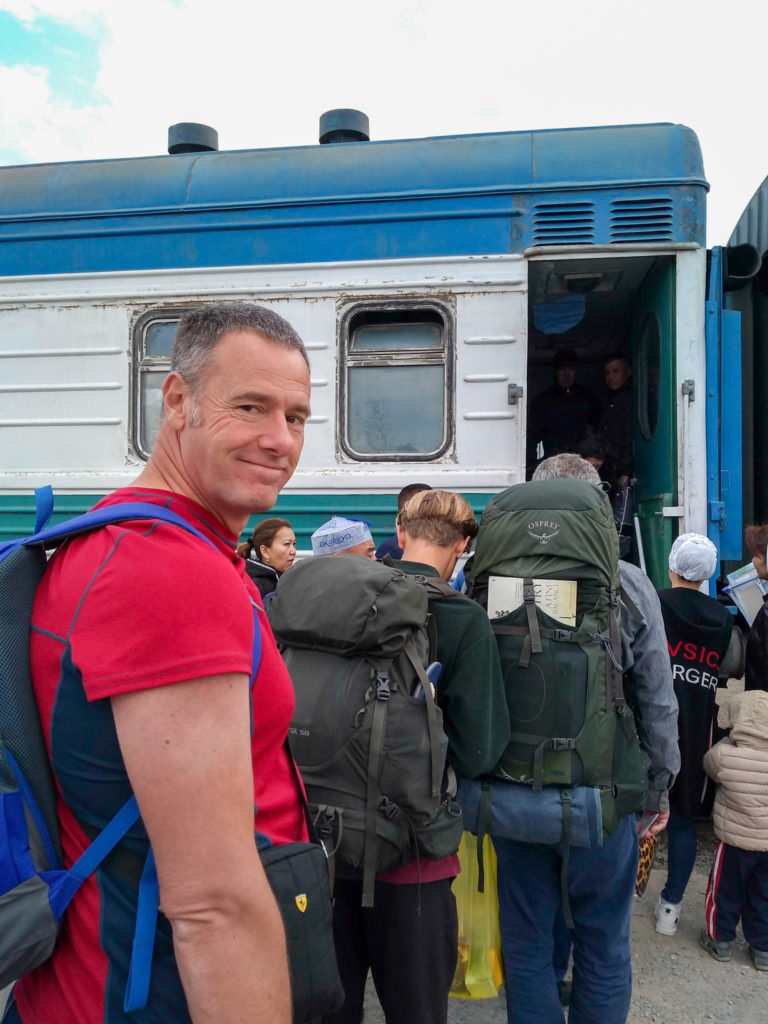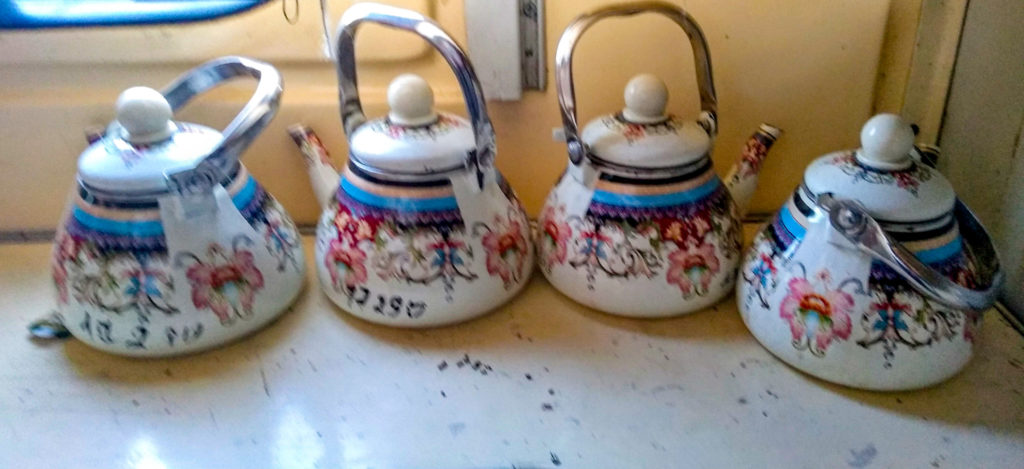Our travels in Kazakhstan
Whilst we were travelling in Kazakhstan, we utilised a number of different modes of transport. Below is a summary of where we went, the mode of transport used, the length of time the journey took, and how far it was.
| Journey | Mode of transport | Distance (miles) | Time taken | Cost per person (Tenge) |
| Kuryk to Aktau | Taxi | 55 | 45 mins | 3,000 |
| Aktau to Nukus (Uzbekistan) | Taxi/Sleeper train | 13/595 | 30 mins/30 hours | 1,000/13,400 |
| Tashkent (Uzbekistan) to Almaty | Sleeper train | 615 | 16 hrs 46m | 312,500 (Som) |

Accommodation
Accommodation is available to suit all budgets in Kazakhstan. Our experience is that you get what you pay for. We stayed in Aktau and Almaty. Using Booking.com and Airbnb to book the accommodation. From our experience both the hotel and apartment that we stayed in were basically furnished but clean.
Don’t expect tea/coffee making facilities in hotels. Bathrooms are western style, with bath and shower. Toiletries were provided.
WiFi may be advertised as being available. Generally, it is but the signal strength and quality can be poor in the rooms that aren’t close to the router.
Train travel
Kazakhstan’s railway network has over 15,000km of 1520mm Russian gauge track from its Soviet past. This allows travel around this vast country. Tickets can sell out very quickly, especially during the summer. Always best to book your tickets a few days in advance. Tickets can be booked in a number of different ways.
Booking online is popular as it can be done whilst on the go. However, this isn’t always possible, booking of tickets at the station is another option.
Online ticket purchases
Purchasing tickets online for travel on Kazakh trains can be done through a number of different sites. The most popular being –
Tickets.Kz
Founded in Ukraine in 2009, Tickets.kz is a member of one of the leading online travel agencies in Europe.
Tutu.ru
Tutu.ru has been operating since 2003. Firstly, the website published suburban train schedules then started selling train tickets. Now it has grown to become a large ticket provider for travellers.
12Go Asia
Provides all travel services on a single platform for comparison and interline ticketing.
Our personal preference was to use Tutu for the purchase of train tickets while travelling both in Kazakhstan and Uzbekistan. We found that the fees were less than the others. Also, the site was simple and easy to use.
Purchasing tickets at a station
Ticket purchases at the station can be a long process. Firstly, the booking clerk probably won’t speak anything other than Kazakh. This makes communicating your preferred train and seats difficult. Secondly, there will be quite a few people buying tickets.
Don’t expect an orderly queue at the counter. Older Kazakh passengers have a tendency to just walk straight up to the counter, regardless of any queue. So prepare for a long frustrating wait if purchasing tickets at a station.
Once you have your ticket, the most important things to know are the date, time of departure, and the carriage number. Check the signboards in the station to find the platform number of the train. The conductor will check your passport and ticket and help you, board.
Kazakhstan trains
There are three types of trains in Kazakhstan. The fast Talgo train. The regular train. And finally the regional train.
The fast Talgo train
A modern, slick train. Commonly found on routes to and from Almaty or Astana (Nur-Sultan). Ticket prices are more expensive, as it is quicker. We used it for traveling from Tashkent in Uzbekistan to Almaty.
The Talgo train has two classes of carriages.
Lyux
Consisting of 2-bed compartments, with or without private bathrooms.
Kupé
Consisting of 4-bed compartments.
The Regular train
The remnants of the old Soviet rolling stock. These trains have an average speed of only 50 km/h, making the long journeys even longer. The Regular train has four classes of carriages. Not all available on every train.
Lyux
Consisting of 2-bed compartments, with or without private bathrooms.
Kupé
Consisting of 4 bed compartments.
Platzkart
Six-bed compartments, 3 beds on one side, and 3 beds on the other. A further 2 beds are on the other side of the carriage. The bottom bed being able to be configured as a table and chairs.

Obshy
Seats only.
The Regional train
Regional trains are generally slow only serving the local area.
Which class should you choose?
Only you know the answer to that question. In our opinion, everyone should try the platzkart at least once. Very sociable despite the language barrier, we had hours of fun communicating with the locals around us. The downside, it can be noisy, get a bit stuffy and towards the end of the journey, a bit smelly.
Lyux and kupé offer more privacy and comfort. Ticket availability will make the decision for you sometimes.
Clean bed linen, pillow, and a blanket are provided regardless of which class you travel in.

Toilets are at the end of each carriage. The cleanliness varies from train to train and carriage to carriage. Generally, there won’t be any toilet paper provided. Toilets are locked anywhere between 15 and 30 minutes before and after stations. Plan using them accordingly.
All carriages have a samovar at one end. A hot water dispenser, allowing tea, coffee or even instant noodles to be made.

Luggage storage is under the bottom bunk.
General tips & advice for train travel
Allow plenty of time between connections. Trains can be an hour late.
Many train stations in Kazakhstan are opulent Soviet buildings, worth having a look at. Restaurant carriages are on some trains. Vendors also get on at most stops, selling various food and drink.
If you are lucky, you may be near an electrical point.
Take food to share (tea/coffee, instant noodles, sausage, cucumbers, bread, biscuits, apples, sweets).
A mug, fork/spoon/knife, toilet paper, plate, and wet wipes are all essential on the long journeys.
Have a comfortable change of clothes to wear onboard (tracksuit, shorts, and T-shirt). Don’t be afraid to ask others to step outside while you change, it’s normal.
If you like lounging around, book an upper bed. The middle bed of platzkart will be folded against the wall, with the bottom bunk used as shared seating during the day.
If you do have a top bed, there is a knack into how to get up there. Just watch the locals and learn. 🧗🛌💤😴


Almaty Metro
Open every day from 0620 hrs until 1130 hrs. Trains run every 10 minutes on weekdays, every 8 minutes during rush hour and every 15 minutes at weekends. There is only one line on the system. Ticket offices are at the entrance of every metro station which is indicated by a sign “Kassa”.
Tokens for the metro are purchased at the ticket office or machine for 80 Tenge each. A prepaid card is also available for 100 Tenge and can be loaded with a max of 60 trips. The card is valid for 3 years.
Entry to the metro is by a turnstile which is operated by the token purchased at the ticket office. One token allows unlimited use of the metro, provided you don’t exit a station.
Expect to have your bags scanned as you enter the metro system.
Almaty Buses
Buses are one of the easiest and cheapest ways to get around the city. Basically two types of tickets for travelling on the bus.
Unified Transport Card
This card costs 500 Tenge, which includes 1 trip and a 420 Tenge card fee, which is repaid on the return of the card. One fare using the Unified transport card is 80 Tenge.
Paper ticket
Purchased on the bus for 150 Tenge per person, per trip. Make sure to keep the ticket, inspections are commonplace on the buses.
Most of the bus routes can be found on Google Maps. Making planning journeys really easy.













